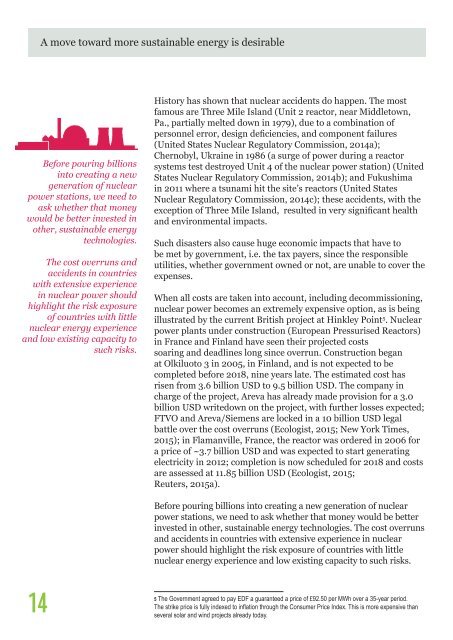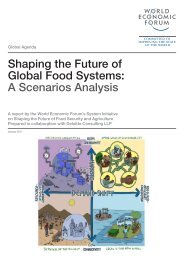Vision 2050
wwf_greater_mekong_power_sector_vision_2050
wwf_greater_mekong_power_sector_vision_2050
Create successful ePaper yourself
Turn your PDF publications into a flip-book with our unique Google optimized e-Paper software.
A move toward more sustainable energy is desirable<br />
Before pouring billions<br />
into creating a new<br />
generation of nuclear<br />
power stations, we need to<br />
ask whether that money<br />
would be better invested in<br />
other, sustainable energy<br />
technologies.<br />
The cost overruns and<br />
accidents in countries<br />
with extensive experience<br />
in nuclear power should<br />
highlight the risk exposure<br />
of countries with little<br />
nuclear energy experience<br />
and low existing capacity to<br />
such risks.<br />
History has shown that nuclear accidents do happen. The most<br />
famous are Three Mile Island (Unit 2 reactor, near Middletown,<br />
Pa., partially melted down in 1979), due to a combination of<br />
personnel error, design deficiencies, and component failures<br />
(United States Nuclear Regulatory Commission, 2014a);<br />
Chernobyl, Ukraine in 1986 (a surge of power during a reactor<br />
systems test destroyed Unit 4 of the nuclear power station) (United<br />
States Nuclear Regulatory Commission, 2014b); and Fukushima<br />
in 2011 where a tsunami hit the site’s reactors (United States<br />
Nuclear Regulatory Commission, 2014c); these accidents, with the<br />
exception of Three Mile Island, resulted in very significant health<br />
and environmental impacts.<br />
Such disasters also cause huge economic impacts that have to<br />
be met by government, i.e. the tax payers, since the responsible<br />
utilities, whether government owned or not, are unable to cover the<br />
expenses.<br />
When all costs are taken into account, including decommissioning,<br />
nuclear power becomes an extremely expensive option, as is being<br />
illustrated by the current British project at Hinkley Point 5 . Nuclear<br />
power plants under construction (European Pressurised Reactors)<br />
in France and Finland have seen their projected costs<br />
soaring and deadlines long since overrun. Construction began<br />
at Olkiluoto 3 in 2005, in Finland, and is not expected to be<br />
completed before 2018, nine years late. The estimated cost has<br />
risen from 3.6 billion USD to 9.5 billion USD. The company in<br />
charge of the project, Areva has already made provision for a 3.0<br />
billion USD writedown on the project, with further losses expected;<br />
FTVO and Areva/Siemens are locked in a 10 billion USD legal<br />
battle over the cost overruns (Ecologist, 2015; New York Times,<br />
2015); in Flamanville, France, the reactor was ordered in 2006 for<br />
a price of ~3.7 billion USD and was expected to start generating<br />
electricity in 2012; completion is now scheduled for 2018 and costs<br />
are assessed at 11.85 billion USD (Ecologist, 2015;<br />
Reuters, 2015a).<br />
Before pouring billions into creating a new generation of nuclear<br />
power stations, we need to ask whether that money would be better<br />
invested in other, sustainable energy technologies. The cost overruns<br />
and accidents in countries with extensive experience in nuclear<br />
power should highlight the risk exposure of countries with little<br />
nuclear energy experience and low existing capacity to such risks.<br />
14<br />
5 The Government agreed to pay EDF a guaranteed a price of £92.50 per MWh over a 35-year period.<br />
The strike price is fully indexed to inflation through the Consumer Price Index. This is more expensive than<br />
several solar and wind projects already today.




